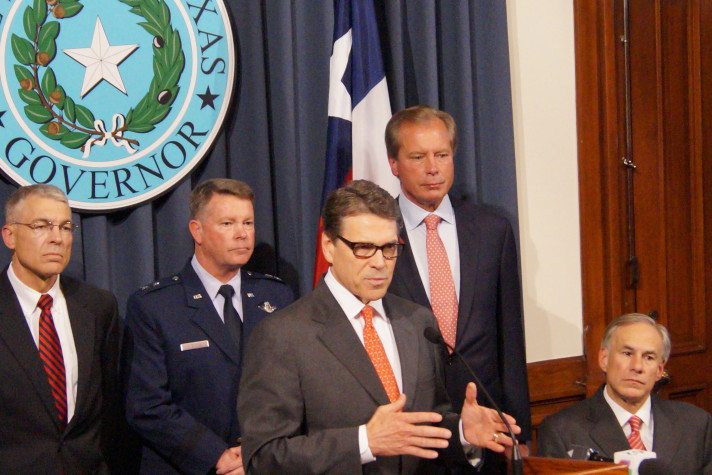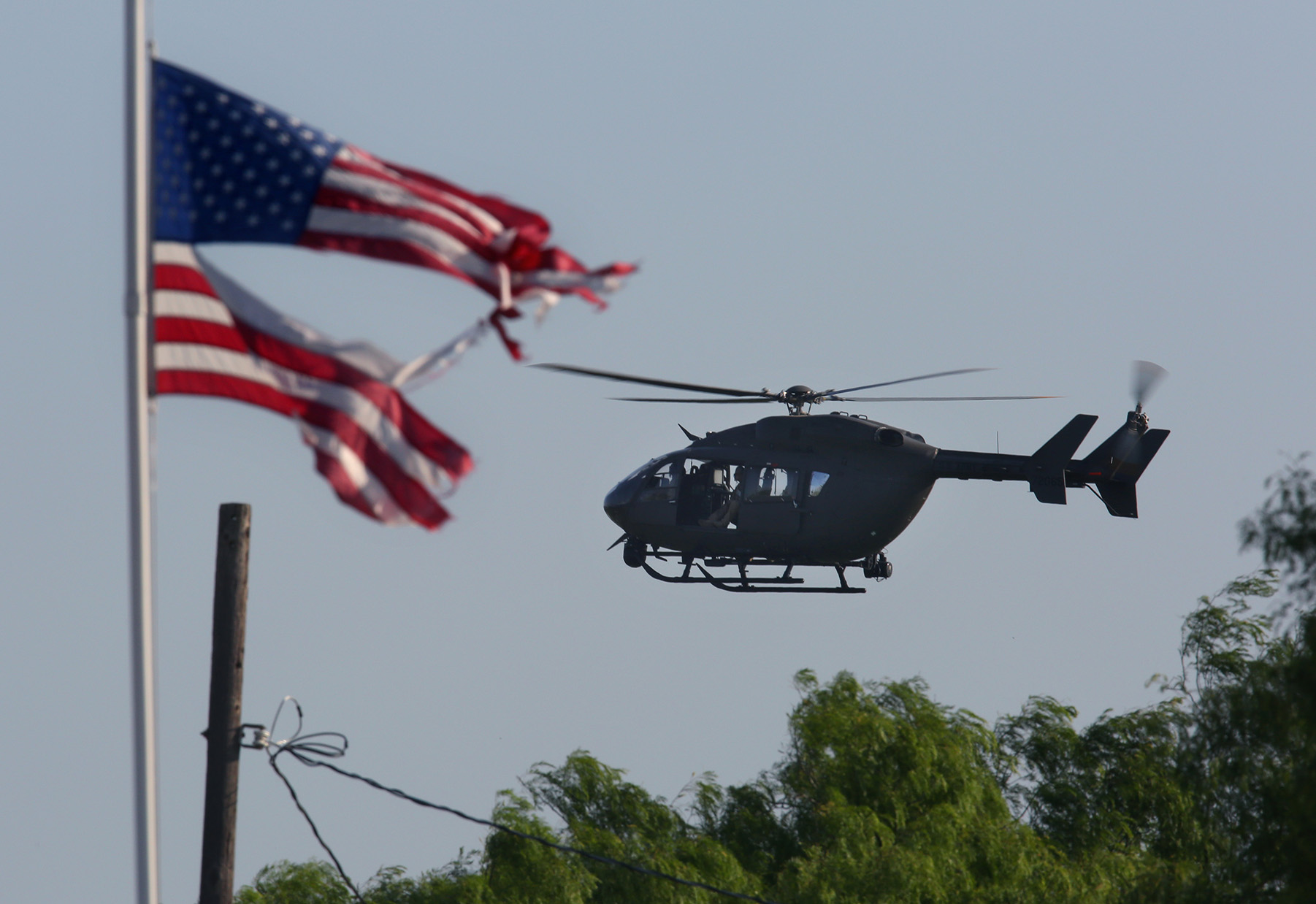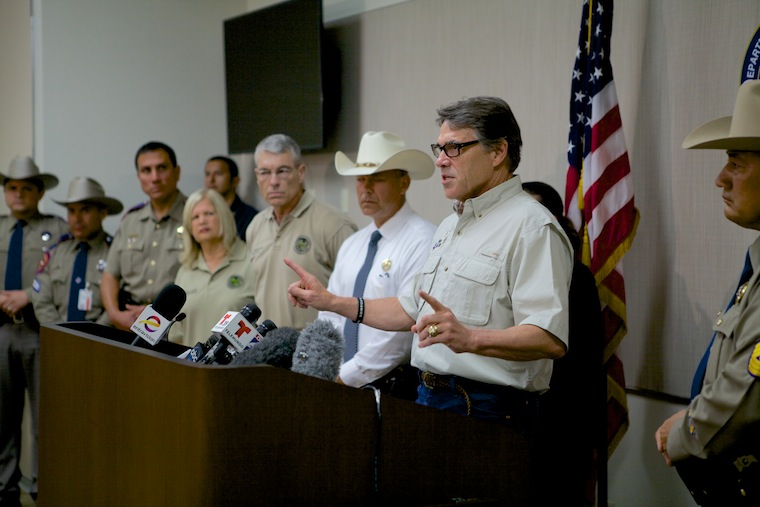
Perry, Dewhurst Take Unearned Credit for Drop in Migrant Crossings

Above: Governor Rick Perry announces the deployment of the Texas National Guard to the border, alongside Lt. Gov. David Dewhurst and Attorney General Greg Abbott
When troopers with the Department of Public Safety first started deploying to the border in June, DPS made clear that they weren’t going to be taking any part in enforcing immigration laws. DPS—much like the forthcoming National Guard deployment—would be on the border solely to assist with law enforcement efforts, like cracking down on drug smugglers. Gov. Rick Perry and others agreed: The deployments were about crime, not the migrants themselves.
But now apprehensions are apparently declining on part of the Texas border, and Texas lawmakers are eager to take credit, even there’s no evidence that the drop in apprehensions has anything to do with Texas’ border surge. To the contrary, the most likely explanations have to do with factors far out of the hands of Texas government. State lawmakers are also changing their story; now the border operations are about immigration enforcement, not stopping drug runners and traffickers.
Gov. Rick Perry was one of the first to take credit for the drop in apprehensions. At his press conference on July 21 announcing the deployment of the National Guard, he credited DPS for staunching the flow. “Apprehensions have dropped 36 percent, from more than 6,600 per week, to 4,200 per week,” Perry said. “This is a clear indication that the increased patrol presence” of DPS and other law enforcement efforts is “having a deterrent effect.”
(I asked Perry’s office for the source of the figures, and the office referred me to DPS. I’ll update when I hear back.)
But last week, Lt. Governor David Dewhurst went much further. On Friday morning, Dewhurst joined Fox News host Bill Hemmer to talk about the border crisis—but an ebullient Dewhurst had one thing in particular he wanted to say.
“As a result of our surge with our state police, Bill, over the last five weeks, we’ve been able to shut down and reduce illegal immigration” in a 60-mile stretch of the “Rio Grande Valley by some 50 percent,” he said. It was a great success, he said, even though the reduction had come at a cost of “$17 or $18 million a month” and the Texas-Mexico border is 1,254 miles long.
Put another way: There was a 50 percent drop in apprehensions, which is an imperfect proxy for illegal crossings, along 4.8 percent of the Texas-Mexico border at a cost of almost $20 million a month. It wasn’t clear what 60-mile stretch of the Valley Dewhurst was talking about. Nor was he asked by the host if apprehensions had gone up elsewhere along the border. If the coyotes are as wily as they’re represented by Texas politicians, then presumably they could lead their clients to a less-policed part of the border.
But most significantly, there’s no evidence that illegal crossings have slowed because of anything Texas is doing. Over the last few months, the U.S government has been involved in a major effort to dissuade Central Americans from making the journey while putting tremendous pressure on Mexico and Central American nations to crack down on migrants. The result of this “containment policy”:
Mexico has quietly stepped up the pace of deportation of migrants, some of them unaccompanied children. It announced plans to stop people from boarding freight trains north and will open five new border control stations along routes favored by migrants.
In particular, the Mexican authorities have cracked down on the use of La Bestia, the train that migrants use to travel from the country’s south to north. The trains run only periodically now, and when they do, armed authorities watch closely. That’s left a lot of Central American migrants stranded in southern Mexico, where, as the Dallas Morning News’ Alfredo Corchado chronicles in an exhaustive account, the situation is going from bad to worse:
At a nearby migrant shelter known as La 72, dozens of men are sprawled on a concrete floor covered with cardboard boxes, swatting mosquitoes. In a separate room, dozens of mothers cuddle their crying babies, quietly pleading for the mercy of sleep to fall on them before sunrise, or for the trains to roar again to continue their journey north.
“The real humanitarian crisis is here in Mexico,” says friar Guillermo Avendaño of La 72, a shelter named in honor of the 72 migrants massacred in 2010 near San Fernando, in Tamaulipas state, on their way to the U.S. “The trains aren’t running, which basically means lives have been interrupted.”
It’s a grave situation that’s left Mexican immigrant rights activists like Father Alejandro Solalinde warning of social instability.
Meanwhile, in the last few months, the U.S. government has been conducting a major effort to convince Central Americans not to come. And the numbers of migrants leaving Honduras, El Salvador and Guatemala have been in sharp decline, according to a New York Times article from July 20:
“It has gone down about 30 percent, the number of children we see passing through here,” said Marvin Lopez, a manager of one of the most commonly used bus lines here. “Not nearly as many families.”
At a police substation on the road to the border with Guatemala, which is about a 45-minute ride from the bus station, officers said that they had been detaining 15 to 20 minors a day in recent months, but that in the past couple of weeks it had dropped to two or three.
Yet the apparent drop in apprehensions has been recast by Perry and Dewhurst as a great policy success of theirs. Their message on the deployments of DPS and the National Guard has been: The federal government is falling down on the job. We’ll act if they won’t—we’ll solve the problem, Texas-style.
But pressure from the U.S. government played a substantial role in reducing the flow of migrants—even if it created more problems elsewhere. You can bet that if the numbers of migrant crossings continue to drop, Perry and Dew will attribute it to the addition of the National Guard to the mix—and if they spike again, they’ll blame the feds.
Texas politicians have changed their stories about the border deployments too many times to count. The DPS deployment was originally supposed to be about targeting drugs and organized crime. But Perry and Dewhurst’s gleeful attempt to take credit for a drop in migration gave away the game. The costly deployments along the border are more about perception than reality.


